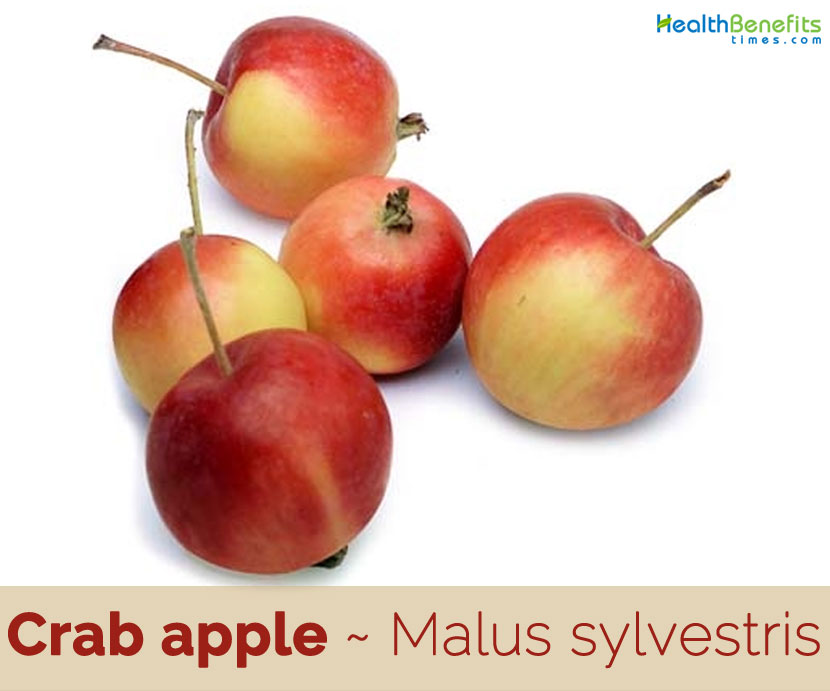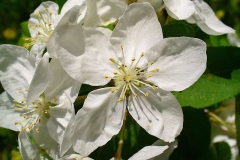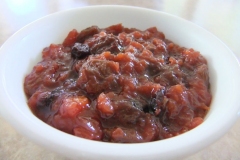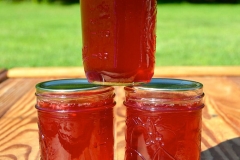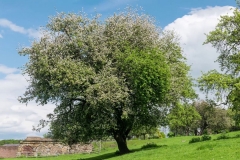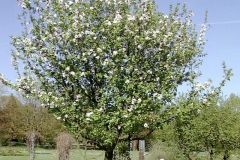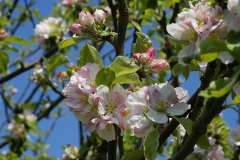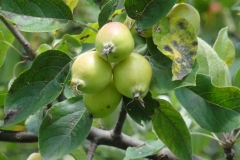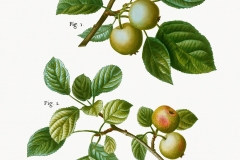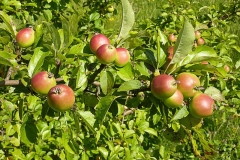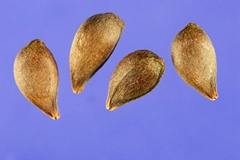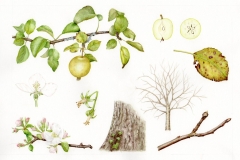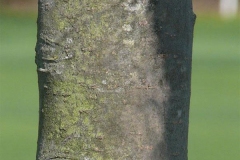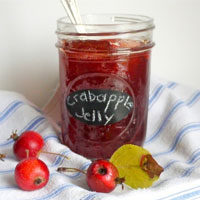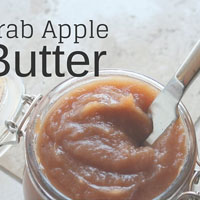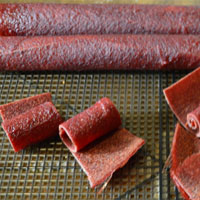Plant Description
Crab apple is a small, dense crowned, rounded, thorny tree or shrub that grows up to 10 m tall with trunk diameters of 23–45 cm, with unarmed or more rarely thorny branches and a brown fissured bark; young growths slightly hairy at first, later glabrous. The plant is found growing mostly at the wet edge of forests, in farmland hedges or on very extreme, marginal sites, Woods, scrub and hedges, especially in oak woods, on neutral to calcareous soils, dry or dryish, rocky broadleaf woods and waterside thickets. The plant succeeds in most fertile soils, including heavy ones, preferring a moisture retentive well-drained loamy soil.
Leaves
Leaves are ovate to elliptic, about 3–15 cm long, 2.5–5.5 cm wide, broadly wedge-shaped to rounded at the base, acuminate at the apex, slightly downy on the veins beneath when young, later glabrous, margins finely but bluntly toothed
Flowers
Buds are egg-shaped, red-green, shiny glabrous. Scale edges are short-haired. Flowers are regular (actinomorphic), large and fragrant. Calyx-lobes are five, narrow-triangular, sharp-pointed, and hairy in the inner surface. Petals are five, inside white, outside pink, with rounded tip. Carpels are three to five and are fused. Inflorescence is an umbel-like cluster of two to six flowers. Flowering normally takes place from April – May
Fruit
Apples and crabapples are in the rose family, Rosaceae, in the genus Malus. Crabapples are distinguished from apples based on fruit size. If fruit is two inches in diameter or less, it is named as a crabapple. If the fruit is larger than two inches, it is classified as an apple.
Fruit is borne in the summer and fall. Crabapple is 2-3 inches in diameter and spherical in shape with a cavity at both ends and crowned with the persistent calyx-lobes. It is initially whitish-yellow in color turning to golden yellow to oranges and the reds through dark-reddish purples as they mature. A ripe crabapple has a hard crust and white pulp. The outer surface of this fruit is rough and plushy. It is sour in taste.
Ornamental vs. Edible Crabapples
There are several types of crabapple trees that produce tastier fruits than others. For example, Centennial and Dolgo crabapples produce tasty fruits that you can eat fresh off the tree. However, other kinds of crabapples, like Chestnut and Whitney, should be saved for baking into pieces, butters, preserves, or sauces. Here are some popular crabapple trees that you might consider growing on your property.
Dolgo
This Crab apple tree grows to about 35 feet in height and is prized for its ornamental and edible qualities. Most people prepare the apples from this tree in sauces, jellies, and ciders. These apples can also be eaten fresh. It is very resistant to certain diseases, like scab, making it a great choice for landscaping as it produces gorgeous white flowers and yellow leaves in the fall.
Centennial Crabapple
This dwarf tree is a good choice, growing up to eight feet in height in most cases. It produces delicious fruits that are great for eating raw or cooking in jellies or butters.
Chestnut Crabapple
The chestnut crabapple endures cold and produces a sweet, nutty fruit. This tree is a great pollinator, and holds up well to being cooked in sauces, jams, and other dishes.
Hopa Flowering Crab
This tree produces gorgeous pink flowers with white centers. It is a bit more vulnerable to disease than some other varieties of crabapple trees, but it’s extremely tough and designed for growing in Zone 2A. It grows to a whopping 25 feet in height.
Whitney Flowering Crab
This is a shorter tree that only reaches about sixteen feet maximum. It produces lovely white and pink flowers that attract birds and other pollinators, but it can also self-pollinate. You can eat the fruits directly of this tree or you can use them in canning or other kinds of preservation, too.
Pink Spires Flowering Crab
The Pink Spires Flowering Crab is a narrow tree that makes it ideal for smaller chunks of property. It grows to about fifteen feet tall and planting one is a great way to attract birds and other pollinating visitors to your land.
Chart of Other Popular Crab apple’s varieties
| Crab apple Quick Facts | |
|---|---|
| Name: | Crab apple |
| Scientific Name: | Malus sylvestris |
| Origin | Temperate regions of North America, Asia, and Europe |
| Colors | Initially whitish-yellow in color turning to golden yellow to oranges and the reds through dark-reddish purples as they mature |
| Shapes | 2-3 inches in diameter and spherical in shape with a cavity at both ends and crowned with the persistent calyx-lobes |
| Taste | Slightly tarty and tasty flavor |
| Health benefits | Immunity booster, Fights high blood pressure issues, Beneficial for bones and other parts of body, Heals wounds, Safeguards from piles and diarrhea, Good source of Vitamin A |
| No. | Name | Size | Shape | Foliage | Flower | Fruit | |
| Height | Wide | ||||||
| 1. | Malus ‘Adams’ Adams Crabapple Deep pink buds open to single pink blooms. This reliable Performer has symmetrical form. |
20 feet | 20 feet | Dense, rounded | Green with reddish
tint in spring |
Deep pink buds open
to pink blooms, single |
Red, 5/8 inches persistent |
| 2. | Malus ‘Adirondack’ Adirondack Crabapple Adirondack is an important cultivar because of its form and outstanding flower display. It is a compact, dense tree with strongly upright form. It produces one of the heaviest flower displays of the crabs. |
18 feet | 10 feet | Densely upright,
inverted cone |
Medium Green | White | Bright red, ½ inches |
| 3. | Malus ‘Cardinal’ Cardinal Crabapple Foliage holds its rich color through the summer and has the best disease resistance of crabs with deep purple leaf color. Flowers of this Malus hupehensis hybrid are bright magenta-pink to red |
16 feet | 22 feet | Broadly spreading | Dark purple-red,
glossy |
Magenta-pink to red | Deep red, ½ inches |
| 4. | Malus ‘Coralcole’ Coralburst Crabapple Top grafted on a 4’ standard, Coral burst is slow growing and forms a very dense, symmetrically rounded head. |
15 feet | 15 feet | Compact, dense,
rounded |
Dark green | Coral pink buds, double rose colored flowers | Yellow-green, 3 ⁄8 inches 1 /2 inches |
| 5. | Malus ‘Dolgo’ Dolgo Crabapple One of the hardiest and earliest of the crabapples to bloom, pink buds of Dolgo open to large, fragrant white flowers. Abundant fruits ripening in mid-summer are edible and excellent for jelly |
30 feet | 25 feet | ‘ Upright, spreading, open | Green, glossy | White, 13/4 inches, single | Red, 11 /2 inches, edible |
| 6. | Malus ‘Donald Wyman’ Donald Wyman Crabapple Glossy clean foliage gives the tree a fresh appearance all summer. Small bright red fruit is among the most persistent of all crabapples. |
20 feet | 24 feet | Rounded | Green, glossy and
clean |
Single, white | Bright red, 3 /8 inches, abundant, persistent |
| 7. | Malus sargentii Firebird Crabapple This compact selection of M. sargentii features long lasting, high quality fruit. Annual fruit display is more persistent than any other natural dwarf crabapple. |
8 feet | 10 feet | Rounded, spreading | Dark green | White, opening from red buds | Bright red, 3 /8 inches persistent |
| 8. | Malus ‘Schmidtcutleaf’ Golden Raindrops Crab apple Fine textured, deeply cut foliage gives this unusual crab a delicate appearance. The form is elegant; with slender limbs spreading horizontally from upright branches. The abundant golden yellow fruit is truly tiny. |
20 feet | 15 feet | Upright, vase shaped | Green, deeply cut | Delicate and star like, white, profuse | Golden yellow and tiny, 1 /4 inches |
| 9. | Malus ‘Hargozam’ Harvest Gold Crabapple One of the best yellow fruited crabs, it features neat, crisp, dark green foliage and an upright branch habit. |
22 feet | 18 feet | Upright oval | Dark Green | White | Yellow, ½ inches, persistent |
| 10. | Malus ‘Indian Magic’
Indian Magic Crabapple Bright red elongated fruit is of unusual shape and makes this tree beautiful in fall. |
15 feet | 15 feet | Upright, spreading | Dark green | Deep pink, 11 /2 inches, single | Orange red, 1 /2 inches, persistent |
| 11. | Malus ‘JFS KW214MX’ Ivory Spear Crabapple Deep pink buds open to white flowers on this densely upright, narrow crabapple. Dark green leaves stay clean and disease free throughout the growing season. Bright cherry red fruits contrast well with the dark green foliage and persist into late autumn, when a touch of yellow fall color adds seasonal interest. Part of the Spear family of trees |
18 feet | 7 feet | Narrow, tightly columnar | Dark green | White | Bright red, 1 ⁄2 inches |
| 12. | Malus ‘Lollizam’ Lollipop Crabapple A compact dwarf tree, perfect for formal gardens, patios and courtyards. Fine textured small leaves and dense growth habit creates a very symmetrical, globe shaped head. It presents a neat and formal appearance throughout the year. |
10 feet | 10 feet | Round, compact | Green | White | Bright red, 3 /8 inches |
| 13. | Malus ‘Louisa’ Louisa Crabapple A pink flowered weeping crab with excellent form and dark green, glossy foliage. |
10 feet | 12 feet | Weeping | Dark green, glossy | True pink | Yellow, 3 /8 inches |
| 14. | Malus ‘Jarmin’ Marilee Crabapple Pink buds open to unusually large, white, double blooms. Unique for its stiffly upright, narrow form and virtually fruitless nature, it is an excellent choice for courtyard settings and streetscapes, and for use near utility lines |
24 feet | 10 feet | Narrow upright, inverted cone | Medium green | Double, large white | Virtually fruitless |
| 15. | Malus ‘Perfect Purple’ Perfect Purple Crabapple Deep pink blooms set the spring stage for dark purple foliage that crowns the perfectly rounded canopy of this attractive tree. Very cold hardy, this crab has performed well in the North and Inter-mountain regions | 20 feet | 20 feet | Rounded | Deep purple | Deep pink to rose red | Purple red |
| 16. | Malus ‘Parrsi’ Pink Princess Crabapple A pink flowered, red leaf form of Sargent Crab. A naturally dwarf tree with all the desirable features of Sargent, but in a new color. |
8 feet | 12 feet | Low, spreading | Purple becoming bronze-green | Rose Pink | Deep red, 1 /4 inches |
| 17. | Malus ioensis ‘Prairie Rose’ Prairie Rose Crabapple Large and fragrant double pink flowers look like miniature rosebuds. Introduced by University of Illinois, this selection of the mid west native crab apple is welcomed for its fruitless character. | 20 feet | 18 feet | Rounded | Medium green | Double, deep pink, fragrant | Usually fruitless |
| 18. | Malus ‘Prairifire’ Prairifire Crabapple One of the best red leafed crabs, Prairifire has impressive landscape impact. Attributes include long lasting bright red flowers, excellent red fruit, and attractive reddish bark. |
20 feet | 20 feet | ‘ Upright, spreading, becoming rounded | Red-maroon, aging reddish green | Crimson buds, bright pinkish red, single flowers | Dark red, 3/8 inches -1 /2 inches, persistent |
| 19. | Malus ‘Profusion’ Profusion Crabapple A popular variety with deep pinkish red flowers and maroon fruit. |
20 feet | 20 feet | Upright, spreading | Purplish when young, maturing to bronze | Deep pink, single | Maroon, ½ inches, persistent |
| 20. | Malus ‘Purple Prince’ Purple Prince Crabapple An outstanding rosy bloom crab. The purple bronze foliage and bright flowers rival Liset, but Purple Prince does not suffer from stem splitting and is faster growing. This is probably the best purple foliaged crab for growers. |
20 feet | 20 feet | Rounded | Purple, becoming bronze green | Rose red | Maroon, 3/8 inches -1 /2 inches |
| 21. | Malus ‘Radiant’ Radiant Crabapple A hardy University of Minnesota introduction, this tree resists fire blight and performs well in the Rocky Mountain and intermountain states |
25 feet | 20 feet | Broad, rounded crown | Red-purple when young, maturing to green | Deep red buds, single deep pink flowers | Bright red, 1 /2 inches |
| 22. | Malus ‘JFS KW213MX’ Raspberry Spear Crabapple Deep pink buds open to bright magenta flowers on this tightly columnar crabapple. Clean and disease-free summer foliage holds its dark purple color; bronzing on the older leaves in late summer and early fall, when orange tints appear. Purple-red fruits ripen to deep bright red and persist into late autumn or early winter. Part of the Spear™ family of trees |
20 feet | 8 feet | Narrow upright column | Purple | Magenta pink | Maroon to deep red, 1⁄2 inches, persistent |
| 23. | Malus ‘Red Barron’ Red Barron Crabapple Ascending branch structure, narrow form and adaptability to urban conditions have earned Red Barron a place on our UtiliTrees™ list. |
18 feet | 8 feet | Narrow, columnar | Reddish-purple, maturing to bronze-green | Dark red, single | Dark red, ½ inches |
| 24. | Malus ‘Red Jade’ Red Jade Crabapple Desirable for its graceful form, white flowers, and its abundant cherry red fruit. Like many of the weepers, it looks its best when grown as a solitary specimen. |
10 feet | 15 feet | Long, graceful, slender weeping branches | Glossy vibrant green | Deep pink buds, white flowers | Bright glossy red, 1 /2 inches, abundant, persistent |
| 25. | Malus ‘Jewelcole’ Red Jewel Crabapple Bright red fruits are among the most profuse and persistent of any crab, holding fast until spring in mild winter areas, when they are replaced by an abundance of white blooms. |
15 feet | 12 feet | Upright and pyramidal | Green | Pure white, single | Brilliant red, 1 /2 inches, very persistent |
| 26. | Malus ‘Rejzam’ Rejoice Crabapple Upright, narrow, and densely branched, this easy care cultivar is among the most uniform looking trees in nursery rows and streetscapes. Red-tinted spring foliage matures to bronze green, becoming deep green in summer. |
20 feet | 10 feet | Narrow, upright oval | Bronze green | Pale rose-pink | Deep red, 1⁄2 inches |
| 27. | Malus ‘Royal Beauty’ Royal Beauty Crabapple Dark pink flowers appear relatively early in the bloom season for crab apple cultivars. Young trees are very narrow and widen with age to become nearly as broad as tall. Deep purple foliage matures to bronze purple in late summer. Dark red fruits persist into the winter months. |
10 feet | 8 feet | weeping | Purple | Dark pink | Dark red, 1⁄2 inches, persistent |
| 28. | Malus ‘JFS-KW5’ Royal Raindrops Crabapple Bright pinkish red flowers and dark purple cut leaf foliage present a combination of colors and textures that is unique among crabapples. Deeply lobed leaves and upright form with good branching and density are inherited from its Golden Raindrops parent. Outstanding nursery growth and good to excellent resistance to the common diseases. www.RoyalRaindrops.com |
20 feet | 15 feet | Upright, spreading | Purple, cut leaf, orange red in fall | Bright pinkish-red | Red, 1 /4 inches, persistent |
| 29. | Malus ‘Royalty’ Royalty Crabapple Perhaps the first purple leaf flowering crab to challenge the purple leaf flowering plums. Flowers are almost the same color as the leaves. |
15 feet | 15 feet | Upright, rounded | Dark purple, glossy | Purple to crimson, single | Dark red, 5/8 inches-3 /4 inches |
| 30. | Malus ‘JFS KW139MX’ Ruby Dayze Crabapple Perhaps the first purple leaf flowering crab to challenge the purple leaf flowering plums. Flowers are almost the same color as the leaves. |
22 feet | 16 feet | Upright, tightly ova | Purple red, becoming bronze | Bright magenta pink | Deep red, 1⁄4 inches |
| 31. | Malus sargentii Sargent Crabapple A natural dwarf with horizontal spreading branches. These are laden with bright red fruits that persist long into the winter months Outstanding when planted in groups. |
8 feet | 12 feet | Low, horizontally spreading | Dark green | n Profuse, single, white, 1 /2 inches, fragrant | Small, ¼ inches -1/3 inches, profuse, bright red, persistent |
| 32. | Malus sargentii ‘Tina’ Sargent Tina Crabapple This most petite of all crabapples is grown as a top graft. Flowers, fruit and leaves are all quite small. | 5 feet | 6 feet | Small rounded dwarf tree | Medium green, small leaves | Bright red buds opening to single white flowers | Bright red, 1 /4 inches |
| 33. | Malus ‘Shotizam’ Show Time Crabapple Heavy blooming, with large bright fuchsia-pink flowers that are striking in spring time. Dark green foliage has a red overlay. A vigorous grower with upright oval form, it features bright red fruits in autumn. |
22 feet | 20 feet | Broadly oval to rounded | Purple bronze to bronze green | Bright pinkish red | Red, 1 ⁄2 inches |
| 34. | Malus ‘Snowdrift’ Snowdrift Crab apple One of the most popular crabs. The crown is very uniform and symmetrical, making it one of the more formal looking crabs. |
20 feet | 20 feet | Upright spreading, rounded and dense | Bright green, glossy | Buds pink, flowers single, white. | Orange, small, 3 /8 inches, persistent |
| 35. | Malus ‘JFS-KW207’ Sparkling Sprite Crab apple Pink buds opening to white flowers smother the dense, rounded head of this top-grafted, compact dwarf. Summer foliage is especially clean and bright green. An abundant fruit crop persists well into winter, slowly turning from golden yellow to orange |
12 feet | 12 feet | Compact, dense, round | Bright green | White opening from pink buds. | Yellow to golden orange, 1⁄4 inches |
| 36. | Malus ‘Spring Snow’ Spring Snow Crabapple Featuring pure white flowers but no fruit; this is the crabapple to use in locations such as patios and courtyards where fruit would be objectionable. It flowers well on an annual basis. |
25 feet | 22 feet | Dense, oval | Medium Green | Pure white, fragrant, single | Nearly sterile. Excellent for patios & courtyards. |
| 37. | Malus ‘Sutyzam’ Sugar Tyme Crab apple Fragrant white flowers smother Sugar Tyme in spring. Persistent red fruits provide a fine fall and winter display |
18 feet | 15 feet | Upright spreading, oval | Green | Pale pink buds, white, single flowers | Red, 1 /2 inches, persistent |
| 38. | Malus × zumi ‘Calocarpa’ Zumi Calocarpa Crabapple Very popular, widely used and time tested; this is a standard for comparison for white flowered crabs. Don’t confuse M. zumi ‘Calocarpa’ with straight M. zumi. | 20 feet | 24 feet | Rounded, gracefully spreading | Large green leaves, dense canopy | Buds red, flowers white, single, fragrant, 11/4 inches | Bright red, glossy, small, 3 /8 inches, persistent |
Health benefits of Crab apple
Crab apples are used as a remedy for various digestive disorders. Ripe crab apples are found to contain powerful digestive agents that assist digestion, while eating unripe fruits without the seeds can alleviate diarrhea and piles. Listed here are some of the popular health benefits of Crab apple
1. Immunity booster
Crab apples also have loads of Vitamin C which also acts as an immunity booster. Vitamin C which is present in crab apples helps you resist fevers, flus and even common cold. Vitamin C also aids cardiovascular diseases as well.
2. Fights high blood pressure issues
Crab apples also provide a very vital vitamin to our bodies i.e. Vitamin D. This vitamin helps to safeguard our body from high blood pressure issues, diabetes and also various kinds of cancer.
3. Beneficial for bones and other parts of body
We all know how important calcium is for our bones and other parts of body. It is especially very important for growing children and women over an age of forty. Crab apples are a good source of calcium too. Regular consumption of crab apples will ensure ample supply of calcium to the body which will keep the bones strong.
4. Heals wounds
Sometimes few of your wounds may take too long to heal. However, if you use an unripe crab apple, it can help you cure the wounds of your body faster than normal. Hence, place an unripe crab apple on the top of your wound for some time, next time you get hurt so that your wound heals faster.
5. Safeguards from piles and diarrhea
Crab apples also help you to prevent your body from effecting from notorious diseases like piles and diarrhea. However, you need to consume ripe crab apples in order to prevent and regulate piles and diarrhea. It is also useful to prevent other health issues that affect the digestive system.
6. Good source of Vitamin A
Crab apples are a rich source of Vitamin A. This vitamin is also known as a fat-soluble vitamin which is very helpful in safeguarding the body from various kinds of dangerous diseases like cancer. Vitamin A regulates the cells which enable the disease to form. The vitamin A in crab apples is also very useful in building up immunity even in kids. As it is a very well-known fact that vitamin A improves eyesight and aids vision related problems.
Traditional uses and benefits of Crab apple
- The fruit is astringent and laxative.
- Crushed fruit pulp can be used as a poultice to heal inflammations or small flesh wounds.
- Fruit is eaten to obviate constipation.
- Bark, and especially the root bark, is anthelmintic, refrigerant and soporific.
- An infusion is used in the treatment of intermittent, remittent and bilious fevers.
- Crab apples lower the risk of both uterine and prostate cancer.
- Crab apples prevent the onset of heart disease and diabetes.
- It address digestive issues and various infections.
- It reduce the odds of infertility issues and premature aging.
- It maintain healthy digestive profile, eyes and heart.
- It strengthen the body’s overall immunity and bone integrity.
- It support both male and female reproductive health.
- Pulp of the unripen crabapple is effective in closing open bleeding wounds.
- It is quite beneficial for scurvy patients.
- Eating unripe crab apple without seeds proves to be highly curative against diarrhea and piles (Hemorrhoids).
- Fully ripened fruit when mixed with sugar and made into syrup helps in overcoming the intense thirst during fever.
- Pulp of a fully ripened crab apple is beneficial for common stomach problems in young children.
- 30-60 grams of this pulp of the fruit should be given to these young children suffering from stomach issues.
- Crust of the wood of the crab apple’s tree is a very good source for curing excessive bile production.
- Poultice made from the boiled or roasted fruit will remove burn marks from the skin.
Other Benefits
- Special paste made from crab apples and some choice ingredients such as dried ginger, salt, honey, and black pepper is found to alleviate hiccups, gum diseases, and throat diseases as well.
- Mixing ground wood crust with pure Ghee of cow and a tablespoon of honey is found to stave off complications after child-birth.
- Leaves of the crab apple tree can also be dried and ground into powder to be taken by people who suffer from infertility issues.
- Consuming powdered leaves with an equal amount of sugar is touted to address premature ejaculation in men.
- Plant’s ample vitamin A supply is beneficial in maintaining eye health and preventing premature aging.
- Fruits are an excellent source of vitamin C that effectively staves off infections such as flu, fever, colds and other medical conditions.
- Fruits are also found to keep cardiovascular diseases at bay.
- Crab apples are particularly rich in iron that helps boost pregnancy health in women as well as endurance among athletes.
- Fruits consist of abundant levels of vitamin D and calcium that strengthen the bones and reduce the risk of developing diabetes, heart disease, and cancer.
- Crab apples, whether eaten ripe or unripe, aid in digestion and alleviate related conditions.
- Juice of the newly sprouted leaves of the crab apple can be mixed with milk and sugar and can be given to young children to solve their bladder problems.
- Mix the pulp of a fruit with jaggery & eat once a day to cure constipation, dyspepsia & mouth ulcers.
- Take 1 cup of fruit pulp twice a day to cure dysentery.
- Mix 1 cup of pulp with 1 tsp. sugar & eat early morning on an empty stomach for 3 days to cure stomach ulcer.
- Take an unripe fruit & pound it along with 1 tsp. each dried ginger & fennel & soak these in 4 cups of water. Sip this water 3-4 times a day for curing piles and hemorrhoids.
Culinary Uses
- Fruit can be consumed raw or cooked.
- It is used for jellies, preserves and juices.
- The flavor improves considerably if the fruit is not harvested until it has been frosted.
- The fruit is rich in pectin and can be used in helping other fruits to set when making jam etc.
- Edible oil can be obtained from the seed.
- Very pleasant tea can be made from the leaves.
Recipes
Crab apple Jelly
Ingredients
- 8 cups crab apples
- 2 cups mild honey, or organic sugar (approximately)
Directions
- Wash the crab apples and remove the stems. Cut each in half to be sure there is no rot or worms.
- Place in a large pot and cover with filtered water. Simmer for about 30 minutes until the crab apples are soft.
- Strain into a jelly bag (juice strainer). Squeezing the bag will produce more juice, but will also cloud the jelly.
- Add ½ cup of mild honey or organic sugar for every cup of juice produced. Boil over high heat until gelling point is reached.
- To test, place a spoonful of jelly on a plate and let cool for a minute in the refrigerator. Then run your finger through the jelly. If it remains separated on the plate, your jelly is done.
- Pour the jelly into hot, sterile 8 ounce canning jars leaving 1/2” space at the top. The jelly may be processed in a water bath canner for 5 minutes (adjust for high altitudes), or may be frozen.
Crab apple Butter
Ingredients
- 12 c. Crab Apple Pulp
- 5 c. Sugar
- 2 med. Oranges (grated zest & juice)
- 1 tsp. Cinnamon
- 3/8 tsp. Nutmeg
- 3/8 tsp. Allspice
Directions
- Combine all of the ingredients in a slow cooker and turn to high.
- Cook with the lid off and stirring every hour or so for 8-10 hours (or until the mixture thickens and cooks down by half).
- The butter is done when it mounds a bit in a spoon. When you place a spoonful of it on a plate, no liquid should leak from it.
Crab apple Fruit Leather
Ingredients
- 10 pounds of crab apples
- sugar, to taste
Direction
- Clean and core the crab apples
- Put the crab apples in a large stock pot. Add 1 cup of water for every gallon of apples. Cook until the apples are soft, stirring occasionally to prevent scorching.
- Run the cooked apples through a food mill to obtain a sauce consistency.
- Sweeten the apple sauce (to taste) before pouring onto dehydrator trays. I usually use ½ cup of organic sugar per 4 cups of apple sauce.
- Prepare dehydrator trays using tray liners, parchment paper or plastic wrap.
- Pour the crab apple sauce on the dehydrator trays. Use a spatula to get every last bit of goodness out of the bowl, and to spread the apple sauce in an even layer over the trays. Keep the sauce at least 2 inches away from the edges of the dehydrator tray.
- Dry at 51 degrees C for 7 to 10 hours, depending on the thickness of the sauce. When it’s completely dry it will be pliable, have no mushy areas, and be evenly firm throughout the thickness of the sheet.
- Once it’s fully dry remove the fruit leather from the dehydrator and remove the plastic wrap. While it’s still warm, cut it into 2 inch wide pieces using sharp kitchen shears, well lubricated with coconut oil.
Toffee crab apples
Ingredients
- 12 good condition crab apples, washed, and remove black flower remnants on bottom of apples
- 12 small kebab sticks
- 200 g sugar
- 1 teaspoon cider or white vinegar
- 1 teaspoon butter
- 3 tablespoons water
- Red food coloring (optional)
Direction
- Press kebab stick into the center (core) of each apple.
- To make toffee, place all ingredients except apples in a pan and bring to the boil.
- Stir until sugar has dissolved. Then boil rapidly for 2-3 minutes, until a small blob dropped into a cup of cold water forms a soft ball. Don’t take your eye off as it burns easily.
- Remove from heat, tilt it to one side and then dip the apples in.
- Give them a slow spin to evenly coat in toffee, then place on a piece of greased baking paper on a tray.
- The toffee takes a minute or two to set.
Other facts
- The fruit is a source of pectin which is used as a thickener in jams etc. and as a culture medium in laboratories.
- Red to yellow dye is obtained from the bark.
- Wood is an excellent fuel.
- Its leaves are food of the caterpillars of the twin-spotted sphinx and possibly the hawthorn moth.
- Due to their versatility, crab apples make excellent choices for use around homes, schools, parks, public and commercial buildings, and in highway plantings.
References:
https://npgsweb.ars-grin.gov/gringlobal/taxonomydetail.aspx?id=23279
https://pfaf.org/user/plant.aspx?LatinName=Malus+sylvestris
https://plants.usda.gov/core/profile?symbol=MASY2
https://en.wikipedia.org/wiki/Malus_sylvestris
http://www.theplantlist.org/tpl1.1/record/rjp-71
http://www.narc.gov.jo/gringlobal/taxonomydetail.aspx?id=23279
http://www.eu-nomen.eu/portal/taxon.php?GUID=D23F35B7-840A-4CF3-8905-C71992E4D673
https://gd.eppo.int/taxon/MABSY
http://treesandshrubsonline.org/articles/malus/malus-sylvestris/
https://www.cabi.org/isc/datasheet/31973
https://hort.purdue.edu/newcrop/duke_energy/Malus_sylvestris.html
https://indiabiodiversity.org/species/show/264810
https://www.jfschmidt.com/pdfs/JFS_CRAB_CHART.pdf


